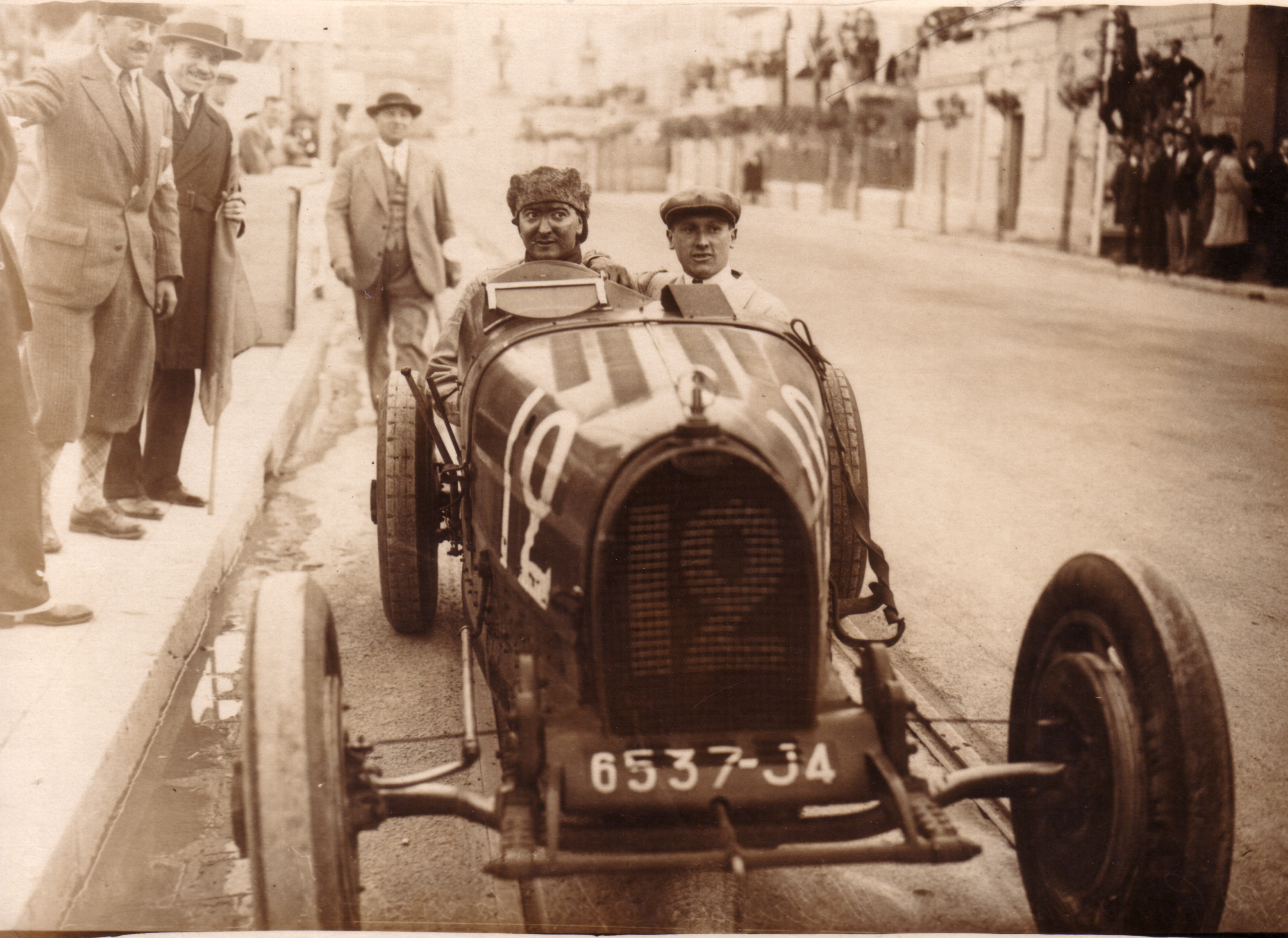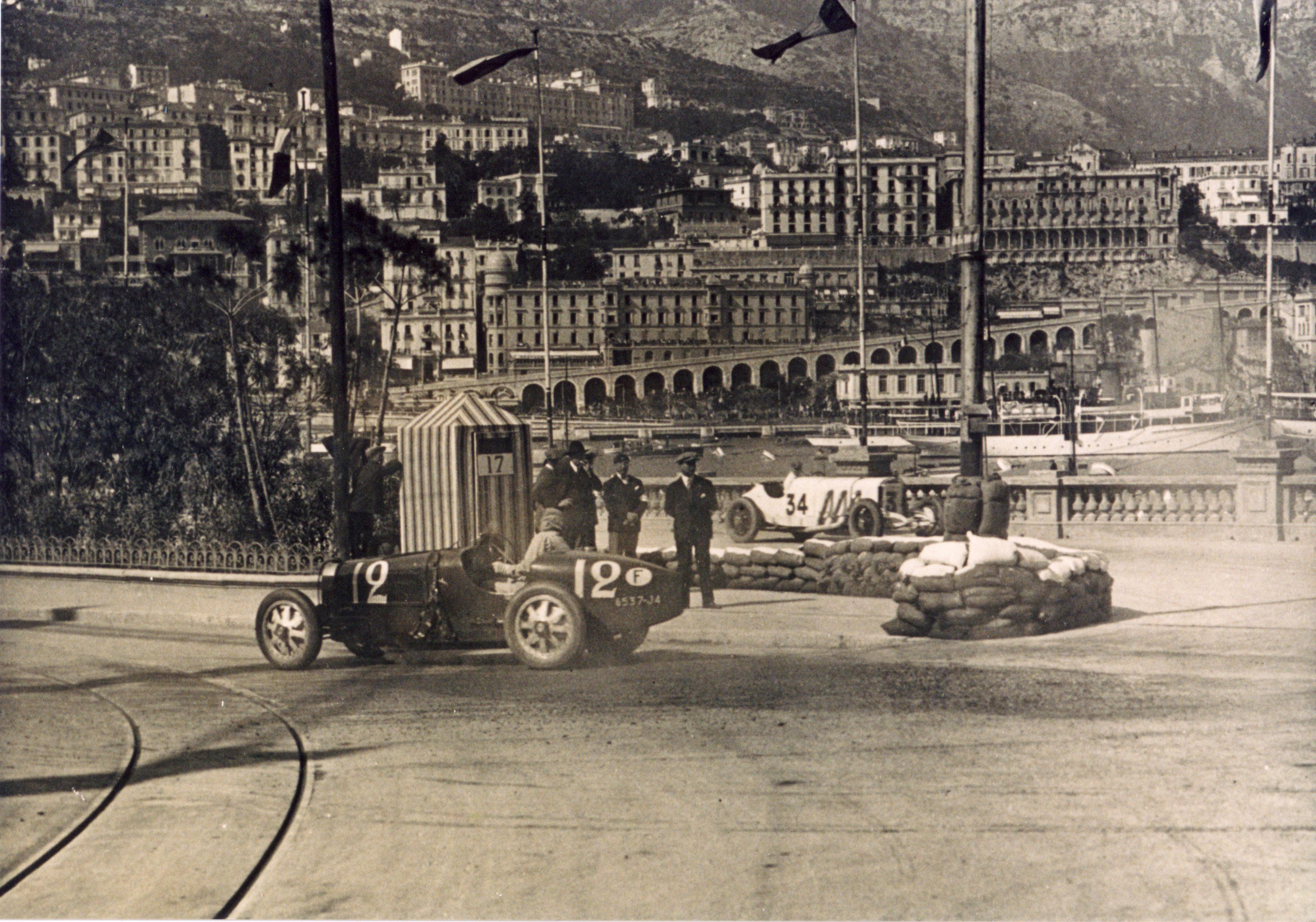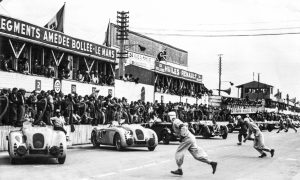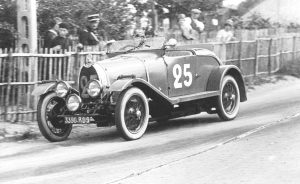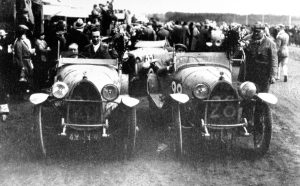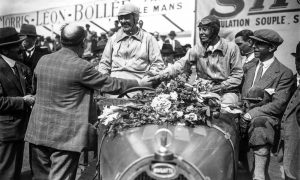Over the ensuing years, Bugatti experienced mixed fortunes at the 24 Hours of Le Mans. Despite a series of solid performances – finishing sixth in 1932, ninth in 1934, and 14th in 1935 – all the ingredients for a Le Mans podium never quite came together. But that would all change in the most astonishing way in 1937
As a response to the new regulations put forth by the organizers of the 24 Hours of Le Mans in 1936, Bugatti promptly commenced work on a new race car – the Type 57 Grand Prix. Later shorted to Type 57G, this car was designed for top-level motorsport, equipped with a 3,266cc in-line eight-cylinder engine, capable of delivering 170 PS. The car’s core structure featured a chassis punctured with holes in a meticulous process to save crucial weight. It was equipped with a full-width, streamlined magnesium-alloy body that encased even the wheels. This distinctive form led to the car being affectionately dubbed the “Tank”. On the iconic back straight of the Circuit de La Sarthe, it boasted a top speed of nearly 220 km/h (135 mph).
It was Jean-Pierre Wimille, the exceptional French driver, who wielded the full might of the Type 57G Tank to maximum effect. In 1937, partnered with Robert Benoist, one of the top French drivers of the interwar period, Wimille piloted the car to a stunning victory. They finished the race having travelled around 100km further than the second-place car, perfectly showcasing the technical genius and pioneering approach of Bugatti. The victory was not only Bugatti’s first win at Le Mans, but Wimille and Benoist also set a new distance record, covering an impressive 3,287 kilometers in a single race.
Wimille’s mastery of the Type 57 was far from exhausted. Although Bugatti had to pull out of the 1938 race with technical difficulties, in 1939, Bugatti and Wimille returned to the Le Mans circuit, this time with Pierre Veyron as co-driver, driving a development of the Type 57G.
Under the streamlined body of his Type 57C there was an upgraded 8-cylinder engine producing around 200 PS. This allowed for speeds of over 255 km/h on the straight and, through additional upgrades, Bugatti managed to reduce the weight of the round, pontoon shaped bonnet. The rear axle, crank shaft and other parts were also optimized.
From the start of the race, the Bugatti faced enormous competition from Raymond Sommer in a new Alfa Romeo. He led the race from the start, but the Bugatti pro drove exceptionally, taking clean lines in the curves while preserving his tires and brakes. Until late at night, the cars were driving with more and more speed. Sommer and Wimille’s fierce fight for first place was soon joined by Louis Gérad and Georges Monnert, drivers for Delage. But their race car could not withstand the strain: on Sunday morning, an engine problem forced them to stop in the pit lane. Meanwhile, Pierre Veyron drove on, pushing the Type 57 C ‘Tank’ lap after lap.
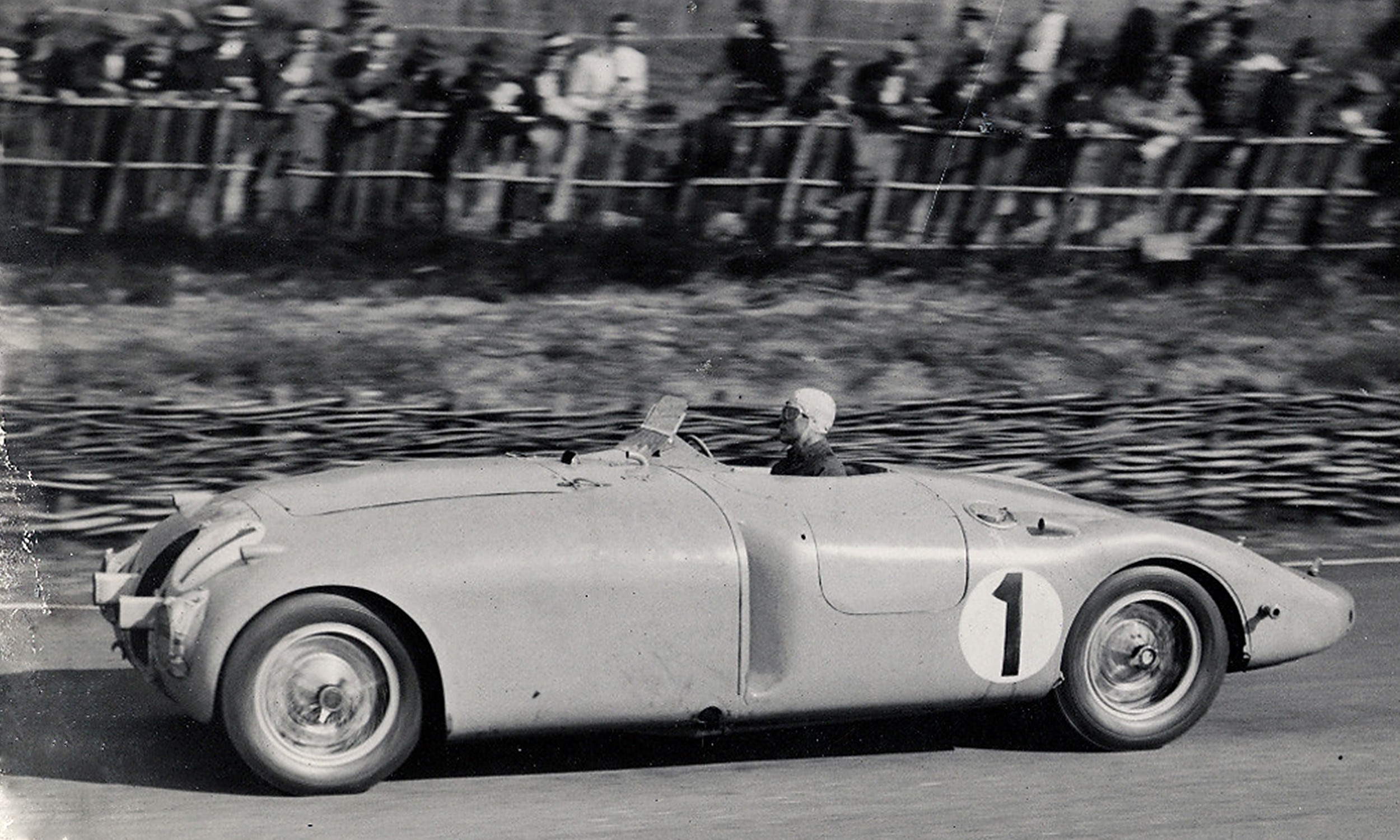
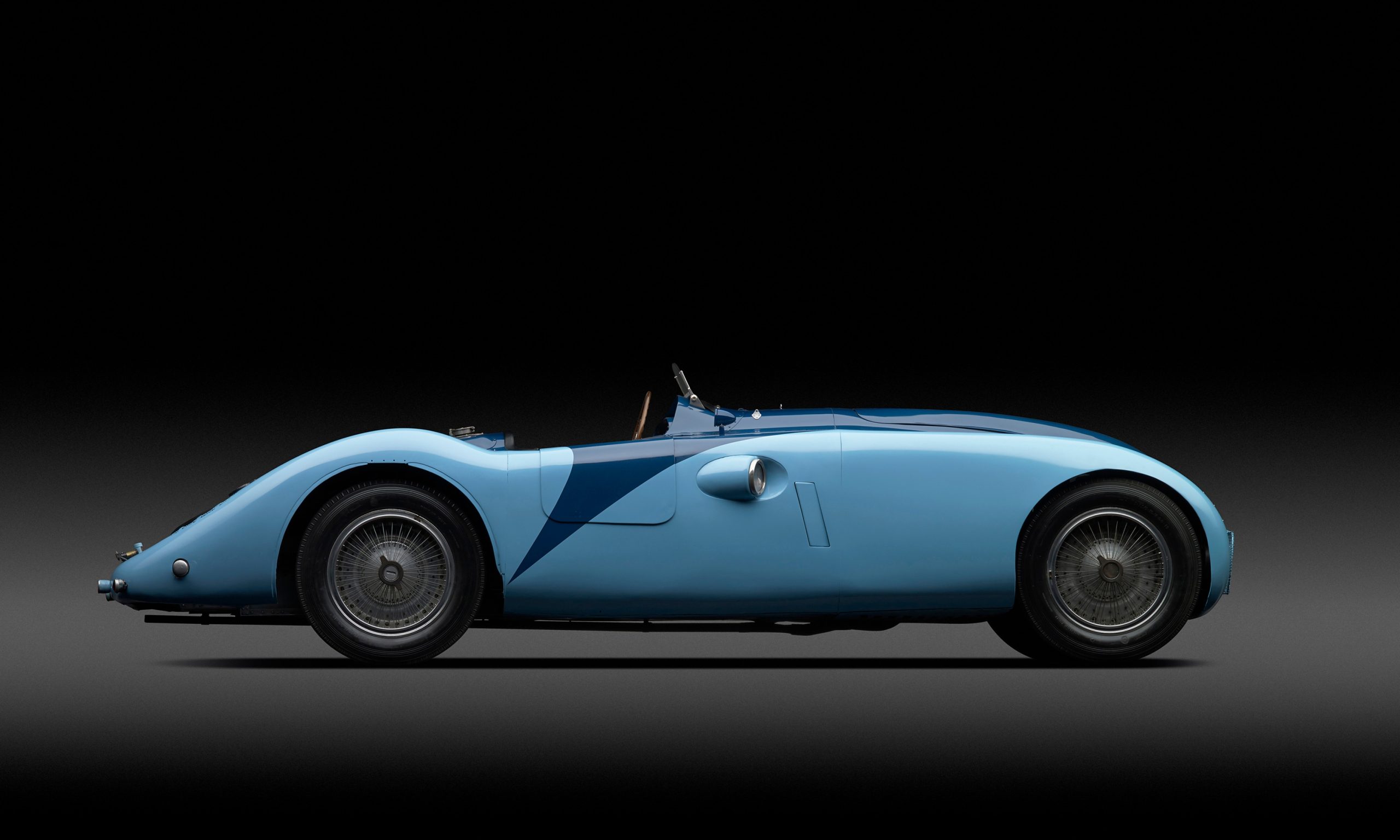
With a track distance of almost 13.5 kilometers per lap, Wimille and Veyron covered 3,354 kilometers – 248 laps – in 24 hours, which earned them an impressive victory. The Bugatti achieved an average speed of 139 km/h, the runner-up car of the race was three laps behind and the third car nine laps. Of the 42 cars that started, only 20 crossed the finish line. Ettore Bugatti would later claim that during the race, the mechanics never once had to open the bonnet, since the 8-cylinder engine was so reliable.
The start of World War 2 marked the beginning of a ten-year hiatus for the 24 Hours of Le Mans. A Bugatti wasn’t seen at the world-famous race until 1994, exactly 55 years after the last victory for the brand from Molsheim. The car in question was an EB110 Super Sport which, unfortunately, suffered an accident caused by a technical problem and couldn’t complete the race.
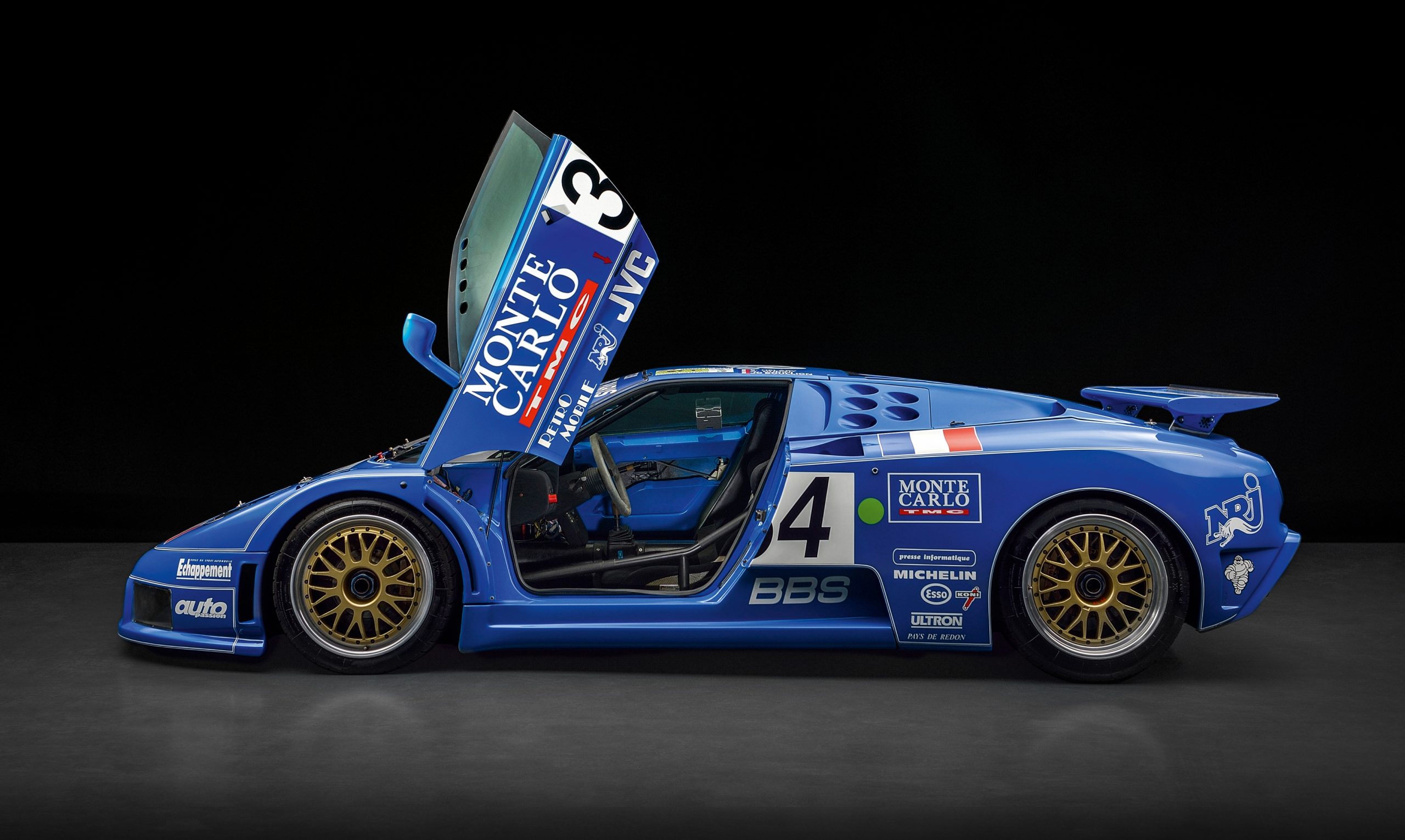
BUGATTI WINS 24 HOURS OF LE MANS HISTORY
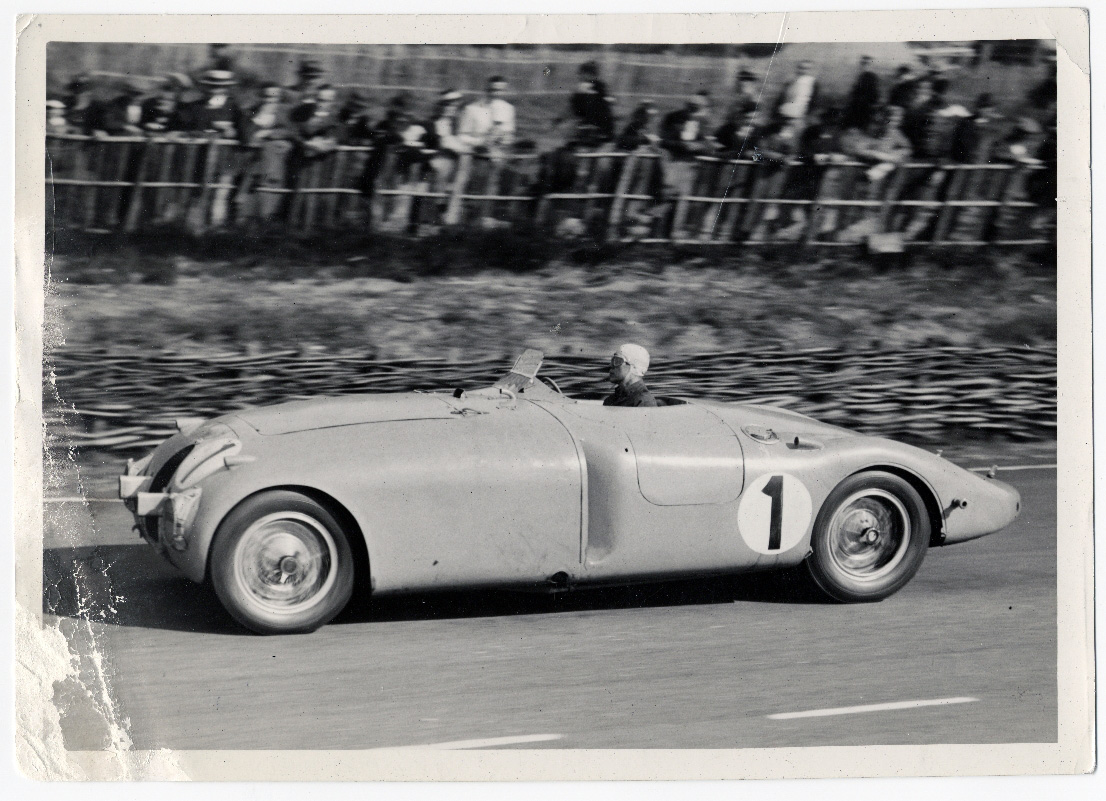
BUGATTI WINS 24 HOURS OF LE MANS 80 YEARS AGO
In 1939, a Bugatti Type 35 C technically close to the production car surprises in Le Mans.
Molsheim, 18. June 2019. It´s one of the most famous and toughest endurance races in the world: the 24-Hours of Le Mans in France. It is the birthplace of legends. Exactly 80 years ago, on the 18th of June 1939 two Frenchman are victorious with their French race car: Jean-Pierre Wimille and Pierre Veyron in a Bugatti Type 57 C Tank. This victory would eventually last for the next ten years.
50 drivers entered the race in eight different categories, but only 42 would actually start the race. 80 years ago, the 24-Hours of Le Mans were already a real constructor’s battle (it should be material battel, but this doesn’t sound 100% correct), although the race did not belong to any racing series back then. The competition was tremendous. Alone 25 came from France, with famous brands like Delahaye, Delage and Talbot. On the starting grid, coming from Germany was, Adlerwerk and BMW, from Great Britain Aston Martin, Morgan, Riley, MG and Singer and from Italy Alfa Romeo.
Bugatti goes to the race with great enthusiasm. The previous year, the French car maker had to renounce their start in the prestigious race due to technical problems. This year however, with the 16th edition of the Type 57, everything is working. Under the streamline body of the Type 57 race version is a nearly series production chassis of the Type 57 C, developed by Jean Bugatti, the brilliant engineer and son of the founder of the company Ettore Bugatti. By charging a compressor, the 8-cylinder engine with 3.3 litre capacity and two overhead camshafts produces around 200 bhp. This allows for speeds of over 255 km/h on the straight. Through additional upgrades, Bugatti managed to reduce the weight of the round, pontoon shaped bonnet. The rear axle, crank shaft and other parts are also optimized.
Bugatti in the Category of Kings
Winners aren’t necessarily the fastest drivers, but rather the most tactical ones with the most reliable racing car. Jean-Pierre Wimille knows the circuit well: two years earlier, the Frenchman wins with a Type 57 G tank with an average speed of 136 km/h. This year, starting in the Category of Kings, where engines range from 2 to 5 litres, it looks good for potential victory.
But from the start on, things are quite different . The favourite is two-time Le Mans winner Raymond Sommer with a new Alfa Romeo. He leads the race from the start and widens the gap with the other drivers, including Jean-Pierre Wimille. But the Bugatti pro drives exceptionally, taking clean lines in the curves while preserving his tires and brakes. Until late at night, the cars are driving with more and more speed. Sommer and Wimille fiercely fight for first place and are soon joined by Louis Gérad and Georges Monnert, drivers for Delage. But their race car could not withstand the strain: on Sunday morning, an engine problem forces them to stop in the pit lane. Meanwhile, Pierre Veyron continues on, pushing his Type 57 C Tank lap after lap. The company’s patriarch later claims that during the race, the mechanics never had to open the bonnet, since the 8-cylinder engine was so reliable.
Bugatti finishes three laps ahead
With a track distance of almost 13,5 kilometres per lap, Wimille and Veyron covered 3.354 kilometres – 248 laps – in 24 hours. The sports car achieved an average speed of 139 km/h. The runner-up car of the race was three laps behind and the third car nine laps. Of the 42 cars that started, only 20 crossed the finish line.
This victory at the 24-Hours of Le Mans 80 years ago in 1939, marked the last great success of Bugatti in motor sports – only two months later, the second world war started. Bugatti had to cease production shortly afterwards, evacuate the factory and could only restart the production with great difficulties after the war had ended. The 24-Hours of Le Mans resumed only in 1949. Although without Bugatti, who still kept the record of covered distance of 3.354 kilometres until 1950. Yet another record for Bugatti.
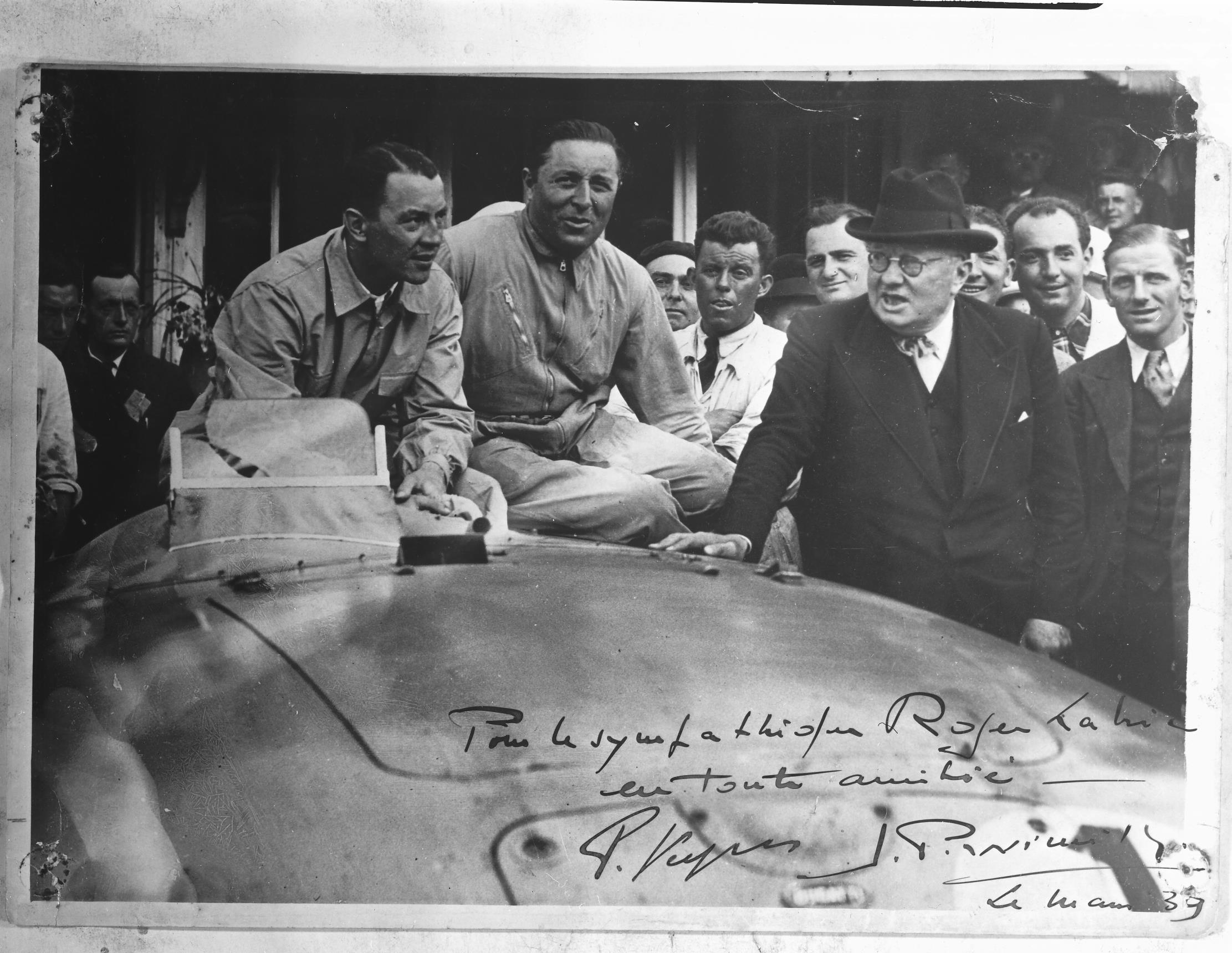
90 YEARS LE MANS – BUGATTI DOMINATES THE FRENCH GRAND PRIX 1929
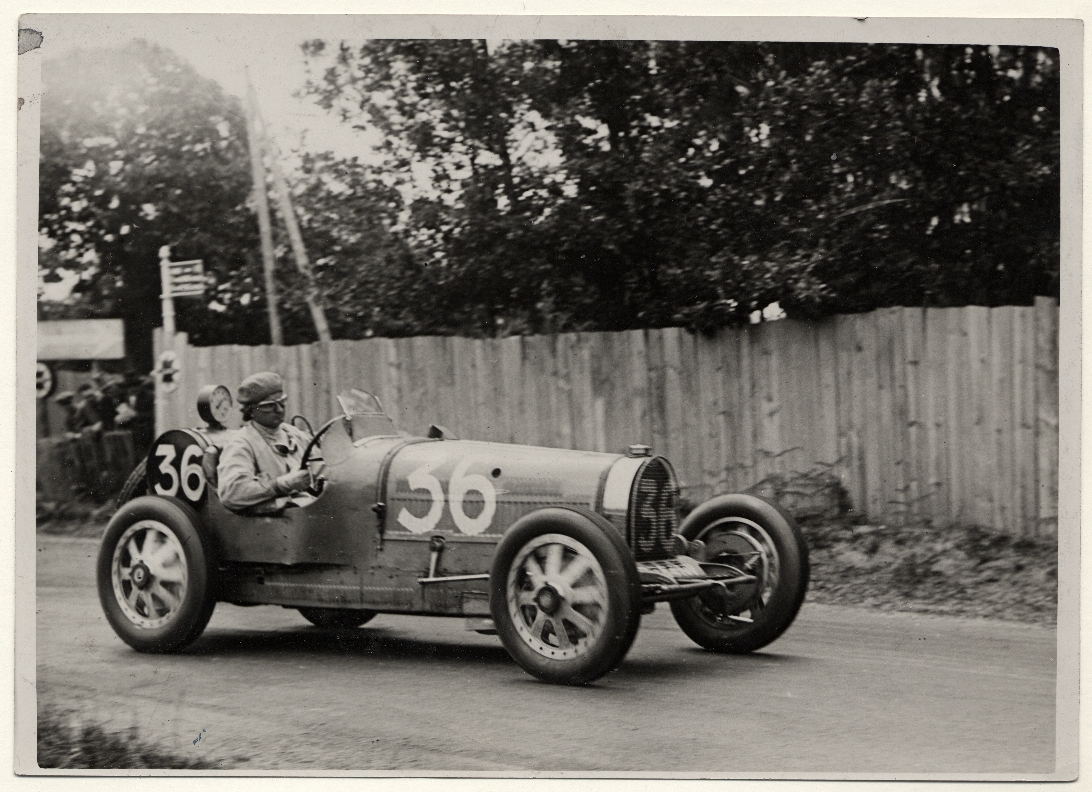
Five Bugatti Type 35 finish in the first six. Williams wins.
Molsheim, 27. June 2019. It is a demonstration of performance with no equal: amongst the six first through the finish line are five Bugatti drivers. 1929 was the year for the French constructor. After the victories in Australia, Antibes, Algeria, Monaco and Targa Florio, the drivers during 15th the French A. C. Grand Prix the 30. June 1929 are unstoppable. The first through the finish line is William “Williams” Charles Frederick Grover driving a Bugatti Type 35 B. He is followed by André Boilot driving in a Peugeot and by the two Bugatti factory drivers, Caberto Conelli and Albert Divo, as well as by the two privateers Robert Sénéchal and Robert Gauthier driving their Bugatti.
85 kilograms of petrol should be enough
No fault allowed, the rules are very strict. The race cars have to use no more than 14 kilograms of petrol and oil for 100 kilometers. The tank is visible, mounted behind the seats with markings giving the information of the volume contained. The day before the race, the cars are filled with 85 kilograms of gas, the cap is sealed and the cars securely locked in the Parc Fermé. On race day, trailers pull the cars to the starting line. Only five minutes before the start, the drivers, with the help of their mechanics, are allowed to start the engine. A very short time to do any technical checkups.
Still, the cars are well prepared. On the starting line are aligned eleven cars, amongst which seven are Bugatti. The battle between Williams in the Bugatti and Boilot in the Peugeot is greatly awaited. The spectators are not disappointed. From the start, the two leading pilots are in pursuit. Boilot gets the better start and leads the race for the first of the 37 laps, with a total of 605 kilometers. To do the 16,36 kilometers lap of the Sarthe circuit of Le Mans, Boilot needs 7:35 minutes, with an average speed of 132,35 km/h. But just behind him: Williams in his Type 35. Whilst the rain starts to fall, the drivers have to reduce their pace and the race gets more intense.
For the second lap, Boilot is going at an average speed of 137,92 km/h, but slows down during the fourth lap. Williams, on the contrary, is gaining in speed. On the sixth lap, the Bugatti driver takes the lead and needs only 7 minutes to do a lap – his average speed is 140 km/h. It is the fastest lap.
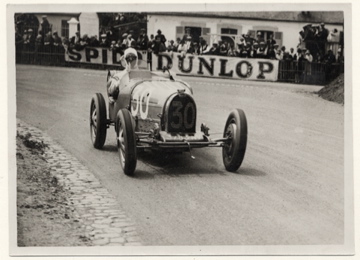
Williams leads from the 12th lap on
From the 12th lap on, Williams has a comfortable lead. This thanks to his skills on track, but also thanks to his car: the Bugatti Type 35 B with its straight six-cylinders, 2,3 liter engine and its compressor, manages to produce 140 bhp at 5000 rev/min. With a total weight of 919 kilograms, including liquids and driver, the Type 35 flies on the Le Mans track. With this weight, the car is just 19 kilograms above the minimum weight allowed by the rules – the other cars are heavier.
Regularly, the drivers check their tank level, slow down if necessary, to keep their chances to overtake the preceding car. Williams keeps his pace lap after lap with his relentless car. Boilot has to stop in the garage because of technical problems and loses precious minutes. After 19 laps and despite the rain coming back, the speeds aren’t decreasing.
Williams leads after 22 laps, 2 hours and 38 minutes with a lead of almost two and a half minutes and manages to extend that lead to three minutes over the following five laps. During the last third of the race, with the rain pouring down, Williams calmly slows down to insure his victory. His fierce rival sees an opportunity and accelerates his pace to close the gap separating them. But Williams isn’t disturbed and calmly finishes his race.
Williams wins after four and a half hours
After 37 laps, 4 hours and 33 minutes, Williams crosses the finish line in first place. His tank remains only eight liters of petrol. Boilot arrives after a minute and 18 seconds, followed by the two Bugatti factory drivers Cabert Conelli and Albert Divo as well as the two private Bugatti owners Sénéchal and Gauthier.
The drivers are exhausted by the events, but happy. The company founder Ettore Bugatti, who naturally followed the French Grand Prix, thanks the three first drivers and company owner Jean-Pierre Peugeot, in his style: he goes for a celebration lap in his personal Type 41 Royale, the most luxurious and best driving car of the world at the time. This was exactly 90 years ago.
Concerning William “Williams” Charles Frederick Grover
The Anglo-French driver was born on the 16th of January 1903 in Paris, from a British father and a French mother. Aged 20, he is hired as private chauffeur by a famous painter of that period. The latter supported the young driver by lending him a car so he could participate in races – under the name W.Williams. With Louis Chiron, Grover opens shortly after a dealership, buys his first Bugatti, a Type 35 and becomes professional driver. After his first victories, Ettore Bugatti sees his talent and makes him factory driver. William Grover will thank him soon afterwards by winning the 1929 Monaco GP and will continue to successfully drive for the French brand until 1933. With the beginning of the second World War, Grover flees to Great-Britain, enrolls in the special forces and is parachuted near of Le Mans. There, he would organize an efficient resistance against the German troops until he arrested in in 1943. He was executed in 1945 in the Sachsenhausen Camp, shortly before the arrival of the Americans.
